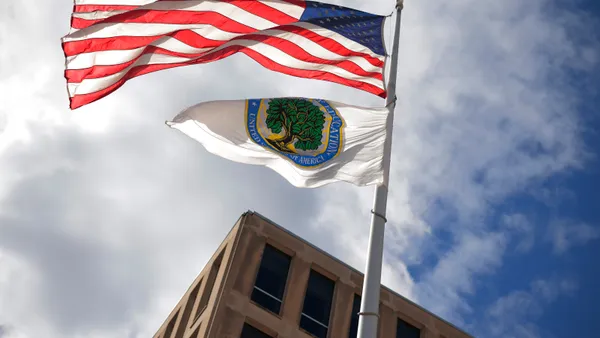Dive Brief:
- If pandemic conditions limit the ability for students to eat school meals together, states will be able to apply for waivers allowing parents and guardians to pick up meals and to lift requirements for "congregate meal service," according to Anne Fiala, senior technical advisor for the U.S. Department of Agriculture’s Food and Nutrition Service.
- In addition, the area eligibility provision — which permits approved programs to serve free summer meals through the Summer Food Service Program — will only be allowed in low-income communities, as determined through Census data or school data showing more than 50% of area students rely on free or reduced-price meals, Fiala said during a Food Research and Action Center webinar Thursday.
- States can still apply for certain nutrition waivers to ensure they meet National School Lunch Act Section 12 (l) requirements when serving school meals. However, that doesn’t include most of the former national pandemic-era waivers on free or reduced-price meals, nutritional content guidelines and federal reimbursement rates, Fiala said.
Dive Insight:
The USDA update shared in the webinar shows the agency is still working to help schools within its legal abilities, school nutrition advocates said. National pandemic-era waivers are set to expire June 30 unless Congress reauthorizes USDA’s authority to extend these emergency provisions.
Fiala said the USDA has been speaking the past several months with state agencies and school meal program operators to understand their concerns and get feedback.
“We heard you, we appreciate your insights, and we acknowledge that the downstream effects from COVID-19 are still happening and they’re far from over, and we’re working hard with you to smooth this transition as much as possible,” Fiala told webinar attendees.
Diane Pratt-Heavner, a spokesperson for the School Nutrition Association, noted that USDA provided states with a checklist of waivers they are still eligible for.
“They’re really making it easy for states to apply for these waivers,” she said.
The state waivers will allow districts to still implement summer grab-and-go meals, Pratt-Heavner said. However, the nationwide area eligibility waiver permitted free summer meals in any area, no matter a community’s income for the previous two years. Without that waiver, there will be fewer opportunities to serve meals to low-income students who need them, Pratt-Heavner said.
“Because we don’t have area eligibility, you’re going to see a massive drop in the number of meal sites this summer, and that’s really disappointing,” she said.
In addition, many schools stopped collecting free and reduced-price meal data during the pandemic, so the available information may not be accurate, she said. It’s possible demographics have changed in some communities and eligibility for free summer meals could be missed, Pratt-Heavner added.
As food costs continue to rise due to inflation, Fiala said, it’s expected that USDA will raise meal reimbursement rates this summer, since they adjust with the Consumer Price Index.
Even so, Pratt-Heavner said this increase typically occurs July 1, which would provide school meal programs with little notice to prepare for the new school year. If the USDA does adjust for inflation, she said it’s still likely the change won’t be as high as the reimbursement rates provided during the pandemic through the federal nutrition waivers.
On top of that, districts will probably have to increase the cost of school meals for the upcoming year, Pratt-Heavner said. There will also be challenges to signing up eligible students for the free and reduced-price meal program because families haven’t had to do this for the past two years with universal school meals in place.











